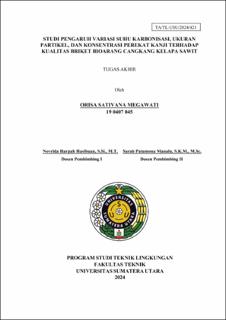| dc.description.abstract | Renewable energy is an environmentally friendly and renewable energy source, so it is a sustainable solution to replace fossil energy which is decreasing. Oil palm shells are biomass waste that is widely found in the plantation sector and has the potential to be used as one of the renewable energy alternatives such as biochar briquettes. This study aims to determine the effect of carbonization temperature, particle size, and starch adhesive concentration on the quality of the biochar briquettes produced. In this study, the palm oil shell was first carbonized with temperature variations of 300°C, 350°C, and 400°C for 2 hours using a furnace. Then it is smoothed with variations in particle size passing the sieve of 80 mesh and 100 mesh, and added starch adhesive with concentrations of 15%, 20%, and 25%. After making briquettes, a proximate, compressive strength, and calorific value test will be carried out. This study uses an experimental method, then the results will be compared with SNI 01-6235-2000 on Wood Charcoal Briquettes and SNI 19-4791-1998 on Coconut Coir Powder Briquettes and data analysis is carried out, namely normality test and data correlation test. The results showed that the quality of biochar briquettes was greatly influenced by the particle size. The best moisture content is found in the variation of 350°C/100 mesh/20%, which is 3.47%, the result has met the quality standards. The best volatility level is found in the variation of 300°C/100 mesh/20%, which is 51.19%, the result has not met the quality standard. The best ash content was found in the variation of 400°C/80 mesh/25%, which was 2.51%, the result had met the quality standards. The best fixed carbon content is found in the variation of 300°C/100 mesh/20%, which is 44.81%. The best compressive strength value is found in the variation of 400°C/80 mesh/25%, which is 35.267 kg/cm2, the result has met the quality standard. The best calorific value is found in the variation of 400°C/80 mesh/25%, which is 4,553 cal/gr, the result has not met the quality standards. In this study, it was found that the higher the carbonization temperature, the higher the volatility level, ash content, compressive strength value, and calorific value will be higher. The larger the particle size will cause the moisture content, the compressive strength value and the calorific value will be higher. The larger the concentration of the adhesive, the higher the volatility level, the compressive strength value, and the higher the calorific value. | en_US |


